The garden is often gray and bare in winter - but not with winter bloomers! You can find out which plants also flower in winter in our overview of winter flowering plants.
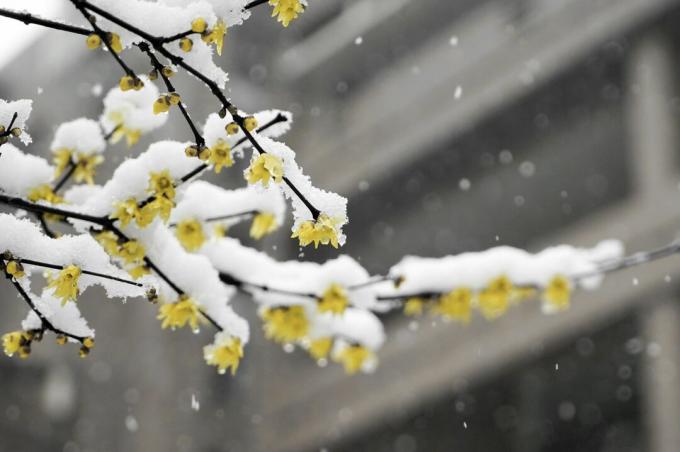
In winter, the garden is often gray and dreary - but that doesn't have to be the case: Winter bloomers provide colorful color accents in winter and enchant us with their bright flowers. In our article we present you today the most beautiful winter bloomers for your garden.
"Contents"
- What are winter bloomers?
-
Which flowers bloom in winter?
- 1. Christmas rose (Helleborus niger)
- 2. Lenten rose (Helleborus orientalis hybrids)
- 3. Snow Heather (Erica carnea)
- 4. Early Spring Cyclamen (Cyclamen coum)
- 5. Snowdrop (Galanthus)
-
Which shrubs bloom in winter?
- 1. Scented snowball 'Dawn' (Viburnum x bodnantense 'Dawn')
- 2. Winter honeysuckle (Lonicera x purpusii)
- 3. Chinese Wintersweet (Chimonanthus praecox)
- 4. Slimeberry (Sarcococca confusa)
- 5. Mahonia 'Winter Sun' (Mahonia x media 'Winter Sun')
- 6. Winter cherry (Prunus subhirtella 'Autumnalis')
- 7. Japanese witch hazel (Hamamelis japonica)
What are winter bloomers?
Plants that bloom from late November to early February are called winter bloomers. However, these are not just winter-flowering perennials – trees and shrubs can also be winter-flowering. A common feature of many winter-flowering plants is their high level of robustness, especially in relation to low temperatures: most winter-flowering plants are extremely cold-tolerant.
Tip: Although winter-flowering plants are often very robust against cold and wind, their flowers are not always so. Anyone hoping for an extraordinary bloom in winter should therefore look for a location that is as sheltered as possible from the weather.
Which flowers bloom in winter?
Flowers that bloom in winter? It really does exist - some plants have colorful flowers even when it's snowing and cold. We present the most beautiful winter bloomers among the flowers here.
1. Christmas rose (Helleborus niger)
A true classic among winter-blooming flowers, the Christmas rose is a well-known garden favourite. The Christmas rose often shows its snow-white flowers in December, which is why it is one of the classic Christmas plants is counted. Although the winter-flowering perennial looks quite delicate, it proves to be surprisingly robust and often flowers even in snow and ice.
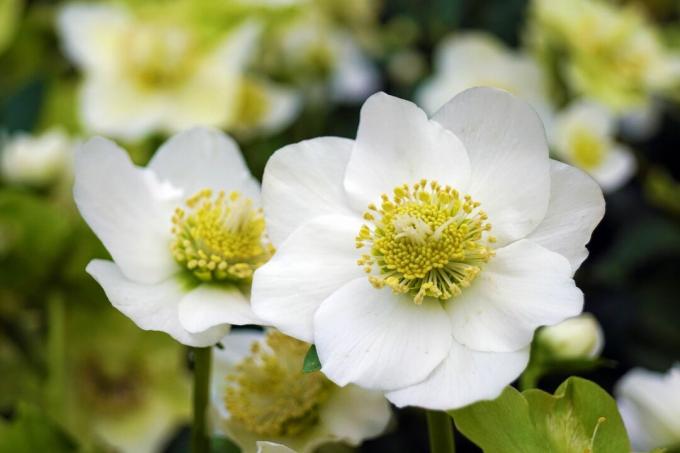
Just the right one Location for the Christmas rose should be considered: It prefers an alkaline to neutral, nutrient and humus-rich soil that is neither too dry nor tends to waterlogging. In addition, a partially shaded location is ideal for this plant. If you can offer the white winter bloomer such a place, the Christmas rose enriches every garden with its beautiful flowers. But not only people love the Christmas rose - due to its long, early flowering from December to March, the winter bloomer is an important source of food for bees.
2. Lenten rose (Helleborus Orientalis-hybrids)
Closely related to the Christmas rose, they also belong Lenten Roses to the classic winter bloomers in the garden. Although the spring rose starts flowering at the beginning of February (earlier in milder weather) than the Christmas rose, this is the reason for that particularly beautiful to look at: in addition to the classic white and cream-yellow flowers, there are also variants with bright pink or black-red Blossoms. The colorful spring roses not only beautify the garden, but also attract numerous beneficial insects such as bees or bumblebees, which find a good source of food there. If you want to plant the winter bloomer, you should put on a permeable, humus-rich loamy soil with a slightly alkaline to neutral pH value. Lenten roses also prefer partial shade under deciduous trees or shrubs.

3. snow heath (Erica carnea)
Pink bell-shaped flowers are the hallmark of the snow heath. From November you can already clearly see the colored flower buds on the plant. However, the main flowering period of the pink winter bloomer does not begin until February and can then extend into March. This early and long bloom makes the winter-blooming heather an important food source for insects. But the snow heath, which is actually one of the dwarf shrubs, is also popular with people: Der Winter bloomer is just as suitable as a container plant on the balcony as it is for the garden or as a ornate Grave planting in winter.
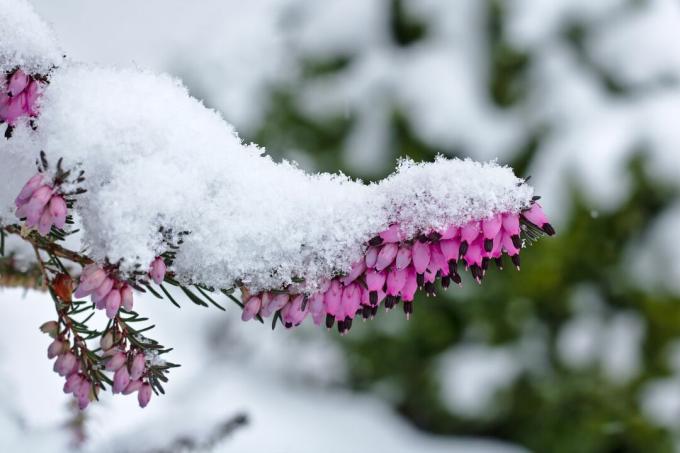
In order for the snow heather to develop its full potential, a sunny to partially shaded location with moderately dry, well-drained soil is recommended. In particular, when cultivating the winter bloomer in a tub, care should be taken to ensure good drainage - the snow heath reacts very sensitively to waterlogging.
4. Early Spring Cyclamen (Cyclamen coum)
A pretty perennial among the winter bloomers is the early spring cyclamen: it enchants with its delicate white, pink or crimson flowers Cyclamen Art Humans as well as bees, which find plenty of pollen and nectar in the plant. Depending on the weather, the early spring cyclamen sometimes shows its delicate flowers as early as December, but its flowering period usually extends from January to March. In order for the winter bloomer to feel comfortable, the location is particularly important: a well-drained and humus-rich soil and a sheltered, partially shaded spot in the garden are ideal for Early Spring Cyclamen. So you can also grow the winter bloomer in a pot if you pay attention to a sheltered location.
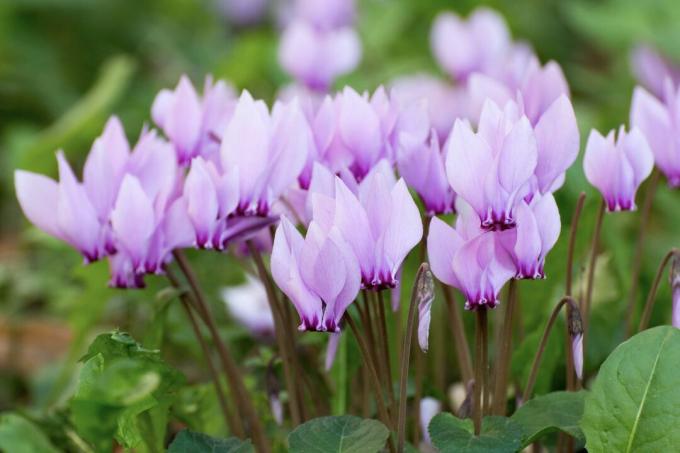
5. Snowdrop (Galanthus)
Snowdrops are very common in our gardens. But did you know that there are 20 different ones Snowdrop Species and there are almost 800 different varieties of snowdrops? Among them are not only early bloomers like the common snowdrop (Galantus nivalis), but also real winter bloomers. The Queen Olga Snowdrop (Galanthus reginae-olgae) shows its white flowers from October to January, for example, and is also conditionally hardy here. The winter bloomers in the garden also include the Voronow snowdrop (Galanthus woronowii), which shows its pretty flowers from January to April. As typical forest plants, almost all snowdrop species prefer a sheltered place under Deciduous trees where they are shaded in summer but have enough light in winter and spring. In addition, the winter bloomers prefer loose, humus-rich soil that does not dry out in summer. If you plant the snowdrop in such a location, it is usually extremely vital and robust.
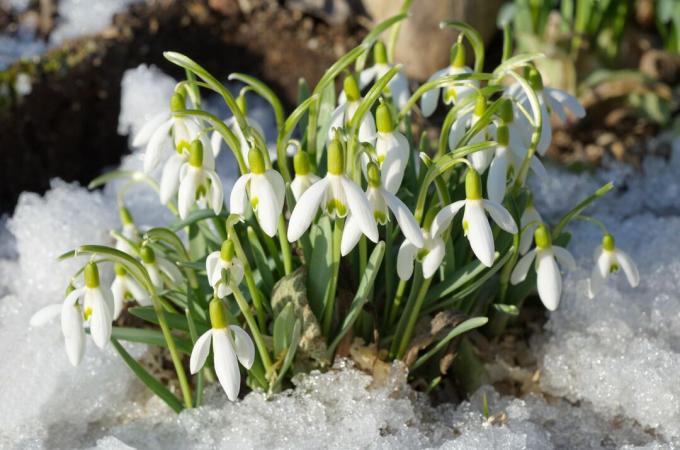
Which shrubs bloom in winter?
Some trees and shrubs provide a splash of color in winter when they suddenly open their buds. No wonder, then, that winter flowering shrubs and trees are popular with many gardeners. We have summarized the most beautiful winter flowering shrubs for your garden in our list.
1. Scented snowball 'Dawn' (Viburnum x bodnantense ‘dawn’)
With its light pink flowers, which also spread a pleasant aroma, the 'Dawn' scented snowball is a real eye-catcher in the garden. As a winter bloomer, the scented snowball 'Dawn' shows its flowers from January to April, in mild winters often even from November. The winter flowering shrub with pink flowers not only enchants people - insects are also attracted to the fragrant flowers. At just under three meters tall, the shrub is suitable for almost any garden if you give it the right variety Location can offer: The ideal location for the scented snowball 'Dawn' should be sunny or partially shaded and sheltered from the wind. be. In addition, a permeable, nutrient-rich soil is an advantage, even if the winter flowering shrub is considered to be very robust and adaptable.

2. winter honeysuckle (Lonicera x purpusii)
As early as January, the winter honeysuckle shows its cream-yellow tubular flowers and is a beautiful sight in the garden. But the winter-blooming honeysuckle is not just something for the eyes - the nose also enjoys the intense honey smell that the flowers exude from January to April. Early wild bees, butterflies and bumblebees are also attracted to the sweet scent of the yellow winter bloomer, which is why it is considered an important bee pasture. With a maximum height of two meters and a compact growth, the winter honeysuckle is also well suited for smaller gardens. The winter bloomer feels most comfortable here if you provide it with a partially shaded spot with loose, humus-rich soil.

3. Chinese Wintersweet (Chimonanthus praecox)
the Chinese winter blossom it opens bright flowers from January to March (in mild winters even from December). The winter bloomer with the yellow star-shaped flowers also impresses with its vanilla scent, which wafts through the garden on sunny days. Unlike many other winter flowering shrubs, the Chinese Winter Flower is totally dedicated to pollination beneficial organisms, which is why they provide plenty of nectar and pollen for early-flying bees, bumblebees and butterflies ready.

The shrub, which is about two meters high, thrives particularly well when planted in a sunny to partially shaded location. In addition, the place should be as protected as possible, since the plant can react sensitively to temperatures below -10 °C. A loose, sandy-loamy soil with balanced soil moisture makes the location perfect for the Chinese winter flowering plant.
4. slimeberry (Sarcococca confusa)
Even if the names slime berry or meat berry sound daunting at first glance, behind it hides an evergreen winter bloomer, which is definitely an enrichment for the garden proves The filigree, cream-colored flowers - which the shrub shows from mid-January to March - make the plant a real eye-catcher. With a growth height of only 50 to 150 cm, the slimeberry is particularly suitable for small gardens. Partially shady or shady locations are ideal for the plant, but above all it prefers acidic to neutral soil that can be well moist, permeable and nutrient-rich.

If you are looking for a winter bloomer among the shrubs, you cannot avoid the mahonia 'Winter Sun': the shrub lives up to its name and adorns itself with numerous bright yellow ones from January to March flower clusters. In addition to their decorative appearance, the flowers also have a sweet honey scent and are considered valuable bee pasture. With a maximum size of 1.50 meters, the mahonia is also suitable for smaller gardens - here the winter bloomer with its evergreen foliage is also more attractive in summer garden dweller.

In order for the mahonia 'Winter Sun' to feel comfortable, a partially shaded or shady, wind-protected location is necessary even in winter. As far as the soil is concerned, the winter bloomer is quite tolerant, even if it prefers nutrient-rich, humus-rich soil.
6. winter cherry (Prunus subhirtella ‘Autumnalis’)
For many gardeners, cherry blossoms are one of the most beautiful sights of the year. The winter cherry, which opens its first pre-blossoms in November and finally blooms into May, makes many hearts beat faster. The winter flowering ornamental cherry impresses with its numerous pink buds and delicate white flowers, which are decorated with striking pink calyx tubes. With a height of up to six meters and the picturesque, spreading crown, the winter flowering tree is wonderfully suited as a decorative house tree. In the right location, the tree is also considered to be extremely robust. A sunny spot with fresh, calcareous loamy soil is ideal for the winter cherry, which is generally considered to be quite undemanding. The winter bloomer is not only popular with humans - insects also appreciate the plant as an early food source.

7. Japanese witch hazel (Hamamelis japonica)
Among the winter flowering shrubs, the Japanese witch hazel is probably one of the best-known representatives. No wonder, after all, the three meter high shrub with its thread-like, primrose-yellow flowers catches the eye from January to March. Insects in particular are impressed by the witch hazel, because the winter bloomer promises plenty of food. who the plant witch hazel should pay attention to the right location: sunny or shaded, the plant is ideally kept in a sheltered spot in the garden. In addition, the Japanese witch hazel prefers fresh, nutrient-rich and well-drained soil with a slightly acidic to neutral pH value.

Not only winter bloomers can decorate our garden with their colorful flowers. In our article we reveal which plants will then convince you with their flowering splendor spring bloomers.



